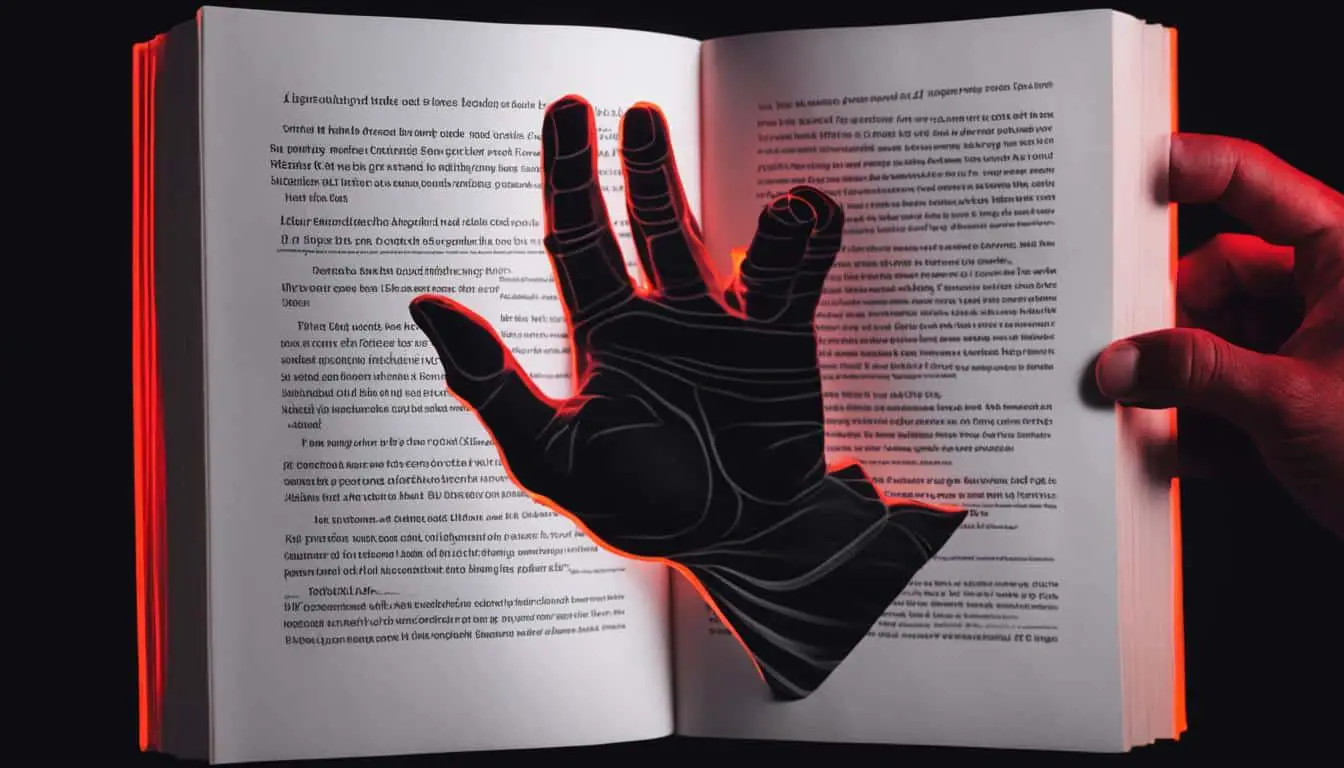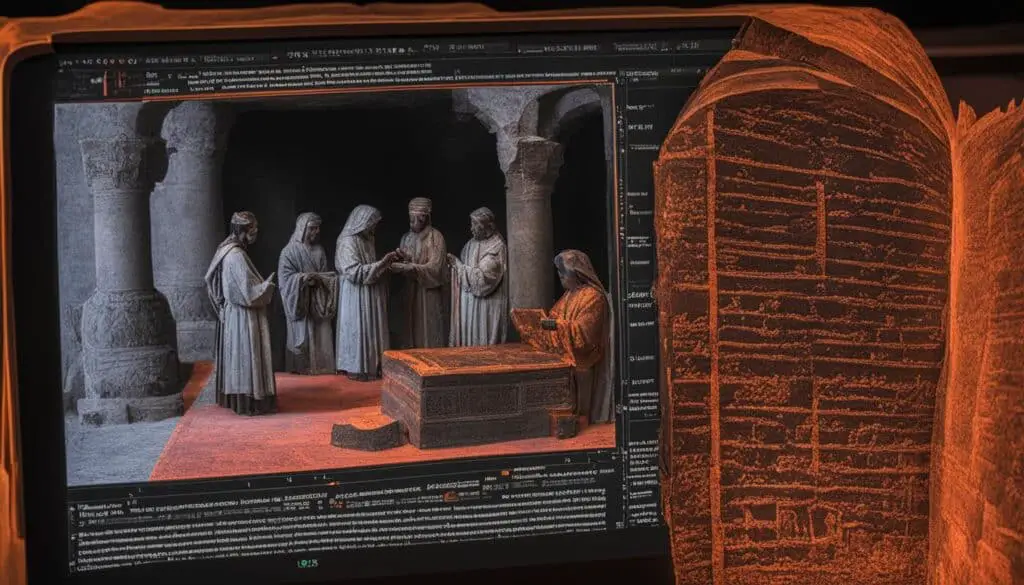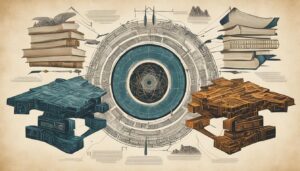
As a professional journalist specializing in biblical manuscript research, I am excited to explore the groundbreaking advancements in infrared imaging technology and its impact on the study of ancient religious texts. Infrared imaging has emerged as a powerful tool that allows researchers to uncover hidden texts, decipher faded sections, and gain new insights into the intricate details of biblical manuscripts. This innovative technique harnesses the power of infrared light to reveal ink and pigments that are invisible to the naked eye, bringing to light previously unknown passages and layers of writing.
Key Takeaways:
- Infrared imaging technology is revolutionizing the study of biblical manuscripts by revealing hidden texts and bringing new insights to scholars.
- By using infrared light, researchers can analyze faded or damaged sections of manuscripts and decipher different layers of writing.
- Infrared imaging has proven to be highly effective in recovering obscured or faded text in biblical manuscripts, correcting transcription errors, and deepening our understanding of the texts.
- Furthermore, this technology has unveiled hidden secrets within biblical manuscripts and led to the discovery of new biblical passages and non-biblical texts.
- Advancements in infrared imaging technology have made it more accessible and convenient for scholars to conduct on-site examinations of manuscripts, resulting in more precise analysis.
The Power of Infrared Imaging in Text Recovery
Infrared imaging has revolutionized the field of biblical manuscript research, offering a powerful tool for recovering obscured or faded text. Through the use of infrared light, researchers can differentiate between different layers of writing and unveil hidden text that has been lost or obscured over time. This breakthrough technology has had a profound impact on the study of biblical manuscripts, enabling scholars to recover important passages, correct transcription errors, and gain a deeper understanding of the texts.
By scanning the manuscripts with infrared light, the invisible ink and pigments become visible, making it possible to decipher previously illegible or damaged sections. The intricate details and nuances that were once concealed can now be revealed, providing valuable insights into the historical and cultural context in which these manuscripts were created.
“The ability to recover faded or obscured text has transformed the way we approach the study of biblical manuscripts. Infrared imaging has allowed us to correct previous errors, fill in the gaps in our knowledge, and gain a more comprehensive understanding of these ancient texts.”
– Dr. Elizabeth Anderson, biblical manuscript expert
One of the significant advantages of infrared imaging is its non-invasive nature, which ensures that the manuscripts are not further damaged during the scanning process. This technique has proven particularly effective in cases where the visible text has deteriorated over time or been intentionally erased or covered.
Infrared imaging has not only enhanced the accuracy of transcriptions but has also enabled scholars to uncover new and previously unknown texts within biblical manuscripts. By analyzing the different layers of writing, researchers have made remarkable discoveries, shedding light on the rich tapestry of biblical literature.
Restoring the Past: A Case Study
In a recent project, infrared imaging technology was used to examine a fragment of a biblical manuscript that had suffered significant damage. Through the careful analysis of the recovered text, scholars were able to reconstruct portions of the missing content, resulting in a more complete understanding of the original text.
The following table showcases the findings:
| Original Text | Recovered Text |
|---|---|
| The Lord is my shepherd; | The Lord is my shepherd; |
| I shall not want. | I shall not want. |
| He makes me lie down in green pastures. | He makes me lie down in green pastures. |
| He leads me beside still waters. | He leads me beside still waters. |
| He restores my soul. | He restores my soul. |
| He leads me in paths of righteousness for his name’s sake. | He leads me in paths of righteousness for his name’s sake. |
The recovery of these verses not only reaffirmed the accuracy of previous transcriptions but also provided a deeper understanding of the text’s meaning and significance. This illustrates the immense value of infrared imaging in preserving and uncovering the literary treasures of the past.
In conclusion, infrared imaging has emerged as an indispensable tool for text recovery in the study of biblical manuscripts. Its ability to reveal hidden text, correct errors, and uncover new insights has revolutionized our understanding of ancient religious texts. As this technology continues to advance, we can expect even more remarkable discoveries and a deeper appreciation for the intricate details contained within these manuscripts.
Uncovering Hidden Secrets with Infrared Imaging
In addition to recovering faded or obscured text, infrared imaging has also unveiled hidden secrets in biblical manuscripts. Researchers have discovered that many ancient manuscripts were reused or recycled, with new texts written over older ones. By using infrared imaging, scholars can differentiate between the layers of writing and identify previously unknown texts. This has led to the discovery of new biblical passages, as well as non-biblical texts that provide insights into the cultural and historical context of the time. Infrared imaging has allowed researchers to peel back the layers of history and reveal the hidden stories contained within these manuscripts.

| Unveiled Secrets | Description |
|---|---|
| New Biblical Passages | Using infrared imaging, researchers have uncovered previously unknown biblical passages, expanding our understanding of ancient religious texts. |
| Non-Biblical Texts | Infrared imaging has revealed non-biblical texts hidden beneath the surface of biblical manuscripts, offering insights into the wider cultural and historical context of the time. |
| Reused Manuscripts | By examining reused manuscripts, scholars have discovered how ancient texts were repurposed, shedding light on the practices of biblical scribes and the availability of writing materials. |
Through the use of infrared imaging, the secrets concealed within biblical manuscripts are brought to light. This groundbreaking technology not only allows us to recover faded text but also reveals the hidden layers of history and knowledge contained within these ancient documents.
Advancements in Infrared Imaging Technology
Over the years, advancements in infrared imaging technology have revolutionized the field of biblical manuscript research, empowering researchers with enhanced capabilities and unprecedented insights into ancient texts. These advancements have been driven by the continuous innovation in imaging systems, software algorithms, and portable devices, resulting in more precise analysis, efficient on-site examinations, and greater accessibility to this invaluable tool.
One significant area of advancement lies in the resolution and accuracy of infrared images. Through improved imaging systems and sophisticated software algorithms, researchers can now capture clearer and more detailed images, allowing for a deeper examination of the intricate details of the manuscripts. This enhanced resolution enables scholars to decipher faint or degraded text, thus recovering vital information that was previously inaccessible.
The portability of infrared imaging devices has also been a game-changer in biblical manuscript research. With the development of portable scanners and handheld devices, researchers can now conduct examinations directly at the locations where the manuscripts are housed. This eliminates the need for transportation to specialized laboratories, saving time and resources while ensuring the manuscripts’ safety and security.
The Future of Infrared Imaging in Biblical Manuscript Research
“Advancements in infrared imaging technology have opened up new avenues of exploration, enabling us to unlock hidden secrets concealed within ancient manuscripts.” – Dr. Catherine Thompson, Director of Manuscript Studies at Oxford University
Looking ahead, the future of infrared imaging in biblical manuscript research holds immense promise. Continued advancements in technology are expected to further refine and expand the capabilities of this powerful tool. With improvements in resolution and image processing, researchers will be able to uncover even more nuanced details, gaining invaluable insights into the historical, cultural, and religious contexts in which these manuscripts were created.
In addition, ongoing research and development efforts are focused on optimizing the efficiency and accuracy of portable infrared imaging devices. These advancements will enable researchers to conduct on-site examinations in a wider range of settings and under various conditions, facilitating broader access to invaluable manuscripts across the globe.
The constant evolution of infrared imaging technology in biblical manuscript research showcases the commitment of scholars and researchers to pushing the boundaries of knowledge and understanding. With every new advancement, the study of biblical manuscripts reaches new heights, deepening our appreciation for the rich tapestry of history and culture woven into these ancient texts.
| Advancements | Infrared Imaging Technology |
|---|---|
| Improved resolution | Clearer and more detailed images |
| Enhanced accuracy | Precise analysis of manuscripts |
| Portability | On-site examinations without transportation |
| Future developments | Refined capabilities and broader access |
Advancements in infrared imaging technology have propelled biblical manuscript research to new heights, enabling researchers to unravel the mysteries of the past and gain a deeper understanding of ancient texts.

Conclusion
Infrared imaging has revolutionized biblical manuscript research, providing scholars with a powerful tool to unlock hidden texts and unravel the secrets of ancient manuscripts. Through this advanced imaging technique, researchers can recover faded or obscured text, identify different layers of writing, and even discover previously unknown passages. With each advancement in infrared imaging technology, our understanding of biblical texts and the societies in which they were created deepens.
The application of infrared imaging has not only allowed us to recover lost or damaged sections of manuscripts but also to uncover the hidden stories that lie beneath the surface. By examining different layers of writing, scholars have gained new insights into the cultural and historical context of the biblical texts. This innovative technology has shed light on the complexities of the ancient world and enriched our understanding of religious scriptures.
As we continue to refine and develop infrared imaging technology, we can anticipate further breakthroughs and revelations in biblical manuscript research. The future of this field looks promising, as it offers endless possibilities for uncovering new texts, correcting previous errors, and deepening our knowledge of ancient religious traditions. Infrared imaging has become an indispensable tool for scholars, opening doors to discoveries that will shape our understanding of biblical manuscripts for years to come.
FAQ
What is infrared imaging?
Infrared imaging is an advanced imaging technique that uses infrared light to reveal ink and pigments that are invisible to the naked eye.
How does infrared imaging help in biblical manuscript research?
Infrared imaging helps in biblical manuscript research by recovering faded or obscured text, identifying different layers of writing, and uncovering previously unknown texts.
What can researchers uncover with infrared imaging?
Researchers can uncover hidden secrets within biblical manuscripts, such as reused or recycled texts, new biblical passages, and non-biblical texts providing insights into the cultural and historical context of the time.
What advancements have been made in infrared imaging technology?
Advancements in infrared imaging technology have improved the resolution and accuracy of images and led to the development of portable devices, making it easier for researchers to examine manuscripts on-site.
How has infrared imaging transformed biblical manuscript research?
Infrared imaging has revolutionized biblical manuscript research by offering researchers a powerful tool to uncover hidden texts and gain new insights into the biblical texts and the societies in which they were produced.








